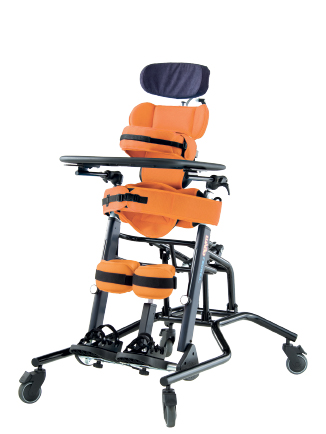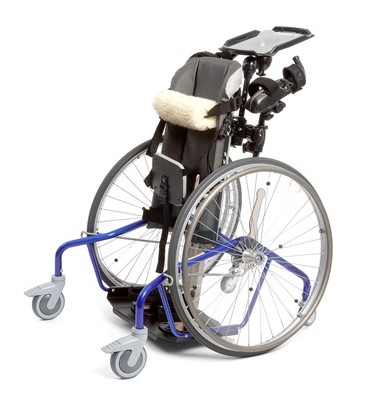Your Child's Equipment
Learning about standing frames
Why is standing important?
Your child’s position throughout the day can impact their ability to engage in their environment. In typical development, children start to play in standing after 9 months of age. Once they’re older than 12 months of age, your child spends the more time in a standing position exploring and interacting with their world. Standing helps support your child’s physical, cognitive, and social development.
Who needs a standing frame?
If your child isn’t standing or starting to explore standing by 12 months of age, a therapist may suggest using a standing frame. This will help your child to stand at an age-appropriate time. Your child might use a standing frame for a short period of time as they work on building their standing skills. Practicing standing at an age-appropriate time can help them work on their balance and strength in their trunk, hips, and legs.
If your child has limited independent mobility, they might use a standing frame for a longer time. Using a standing frame long term can provide your child with all the benefits of standing.
- supports digestion and helps manage constipation
- bone and joint development
- prevents and manages tight muscles
- skin health
- breathing
- social interaction
What are the different types of standing frames?
Many different types of standing frames are available to support your child throughout their life. It’s important to talk to your healthcare provider about the best match for your child and your family.
Upright stander

Photo credit: Leckey
This style of standing frame supports your child from behind. It’s often used to help younger children learn the skill of standing. There’s a sturdy frame and soft straps that are used to help support your child in a standing position. These standing frames are usually used for short periods of time.
Prone standing frame

Photo credit: Rifton Equipment, 2017 (rifton.com)
This style of standing frame supports your child from the front. This means their chest, stomach, knees, and thighs are all supported. These standing frames are tipped slightly forward. They also have the option to have a tray attached at chest height. Your child will need to be able to help you get them into this standing frame by using a supported standing transfer. This is when your child can take some weight through their legs as you also provide support to help them move from one surface to another.
Supine standing frame

Photo credit: Leckey
This style of standing frame supports your child from the back. These standing frames can be positioned flat to help get your child into them. The standing frame will then incline slowly to get them into standing. These standing frames provide the most support.
Mobile standing frame

Photo credit: Rifton Equipment, 2017 (rifton.com)
Like the prone standing frame, this style of standing frame supports your child from the front. The main difference is that there are 2 large wheels on either side. This allows your child to push themselves around while in a standing position. Your child will need to be able to help you get them into this standing frame using a supported standing transfer.
When should you call for help?
Contact your therapist if:
- Your child is not comfortable in the equipment.
- Your child has grown.
Contact the vendor if:
- There are broken parts on the equipment.
- Annual maintenance for moving parts.
To see this information online and learn more, visit MyHealth.Alberta.ca/health/aftercareinformation/pages/conditions.aspx?hwid=custom.ab_childs_equip_standing_frames_inst.

Related to Your Child’s Equipment
For 24/7 nurse advice and general health information call Health Link at 811.
Current as of: October 31, 2024
Author: Pediatric Rehabilitation Services, Alberta Health Services
This material is not a substitute for the advice of a qualified health professional. This material is intended for general information only and is provided on an "as is", "where is" basis. Although reasonable efforts were made to confirm the accuracy of the information, Alberta Health Services does not make any representation or warranty, express, implied or statutory, as to the accuracy, reliability, completeness, applicability or fitness for a particular purpose of such information. Alberta Health Services expressly disclaims all liability for the use of these materials, and for any claims, actions, demands or suits arising from such use.
